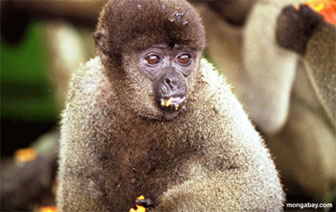Small farmers good, big farmers bad for forest conservation say researchers
Small farmers good, big farmers bad for forest conservation say researchers
mongabay.com
August 8, 2006
Researchers presenting today at two symposia at the Ecological Society of America meeting in Memphis, Tennessee argue that the rural farmers are not necessarily at odds with efforts to preserve biodiversity in developing countries.
Citing case studies in Brazil, Mexico, and other tropical areas, University of Michigan researchers John Vandermeer and Ivette Perfecto suggest that peasant farming practices encouraged by grassroots movements may actually support conservation, while activities by wealthy landowners often undermine it.
“When you talk to peasant producers in tropical areas, they’re usually surprised when they hear that conservationists think that they’re the enemies of conservation,” said Vandermeer, who is the Margaret Davis Collegiate Professor of Ecology and Evolutionary Biology. “They love their farms and all the plants and animals in the area, and they see that it’s the big, rich landowners who come in and cut all the trees down and turn the land into cattle pastures. So the standard litany doesn’t ring true to them.”
 Photo by Rhett A. Butler |
To develop their theory, Vandermeer and Perfecto examined earlier studies of biodiversity in the Mata Atlantica, a region of the biologically-rich Atlantic coastal rainforest in Brazil that is adjacent to highly industrialized areas like Rio de Janeiro and Sao Paulo.
“The area has some of the highest biodiversity in the world, but it all occurs in fragments of forest,” Vandermeer said. “We know that a lot of organisms typically live in a fragmented state in nature, with subpopulations scattered around an area.” While disease, predators, or other causes may wipe out a particular subpopulation, migrants from nearby fragments come in and establish a new subpopulation. “We now think that most high diversity situations operate this way, with a continual process of local extinction and re-migration. When you couple that ecological theory with the observation of highly fragmented forests in the Atlantic coast rainforest, the real question is not how much forest is left, but what’s between those patches that are left, and will it support the necessary migrations from patch to patch as local extinctions occur, which they inevitably do?”
Vandermeer and Perfecto say that small farmers’ use of agroforestry techniques — whereby a variety of fruit and timber trees are planted with with other crops — enable wildlife to more easily migrate between forest fragments than when forest patches are separated large fields of single crops, as is often the case with large-scale landowners.
“The kind of agriculture [agroforestry] that peasant farmers actually do… [is] the kind of agriculture that’s friendly to biodiversity,” said Vandermeer. “These farmers actually have monkeys that come through their farms.”
With grassroots groups such as the the Landless Workers’ Movement (Movimento dos Trabalhadores Rurais Sem Terra, or MST) encouraging such biodiversity-friendly practices, Vandermeer said, “I think conservationists and rural peasant movements ought to be friends.”
RELATED ARTICLE
Conservation of Brazil’s Atlantic forest a key priority at conference in Brazilia
Last year nearly 2,000 of the world’s leading environmental scientists of various disciplines met in Brasilia to present papers at the 19th Annual Meeting of the Society for Conservation Biology. The conference featured more than 750 oral presentations and 965 scientific abstracts. Below is a sampling of some of the Brazilian Atlantic forest conservation-related papers submitted for the conference. What percentage of native cerrado and Atlantic forest remains in the triangulo mineiro region of Brazil? Living in an empty forest: density and population size of game birds and mammals in the Atlantic forest of Brazil. Density of introduced mammals and their impacts in a land-bridge island in the Atlantic forest. The dark side of the “ecotourism” in a hotspot national park of the Atlantic rainforest, Brazil. Importance of habitat area and landscape context for fauna richness in semidecidous Atlantic forest. Small mammals and the landscape structure of an Atlantic forest fragmented landscape. The role of forest structure, fragment size and corridors in maintaining small mammal abundance and diversity in an Atlantic forest landscape. Mapping the risks to the biodiversity in a conservation unity of Atlantic forest. Bat communities (mammalia: chiroptera) in Atlantic rain forest fragments of northeast Brazil. Leaf-litter ants and the conservation priorities in the Atlantic rainforest of northeastern Brazil.
This article is based on a news release from the University of Michigan.